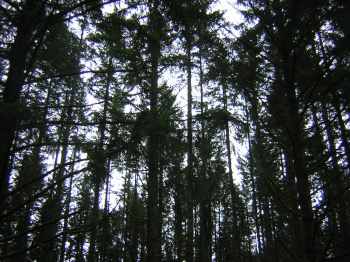
Publisher:
Bonnie King
CONTACT:
Newsroom@Salem-news.com
Advertising:
Adsales@Salem-news.com

~Truth~
~Justice~
~Peace~
TJP
Oct-28-2006 11:37

 TweetFollow @OregonNews
TweetFollow @OregonNews
OSU College of Forestry Celebrates a Century of Growth And Change
Salem-News.comMajor efforts are now in place to increase the numbers of women and minorities involved in forestry careers.
 Salem-News.com |
(CORVALLIS) - The College of Forestry at Oregon State University now has a student enrollment of more than 600, about 15,000 acres of college forests, 5,500 graduates and annual expenditures of more than $26 million, including 46 percent from grants and contracts.
The first degree program that began in 1906, however, was more modest.
There were four students in the first graduating class at what was then called Oregon Agricultural College, including T.J. Starker, a pioneer in the development of the Oregon forest products industry and whose family later sponsored the Starker Lecture Series that is prominent to this day.
In a state with an economy built on agriculture and forestry in the early 1900s, the research and educational programs grew quickly. It became the OSU Department of Forestry in 1908, the School of Forestry in 1913 and the College of Forestry in 1983. What is now the Oregon Forest Research Laboratory began in 1941, and the creation of the Department of Forest Science in 1976 recognized the broader growth of forestry research into ecology, genetics, soils and other specialized fields.
The first female forestry student did not graduate from the school until 1945, as forestry was then a male-dominated field. Women now comprise about one-third of total enrollment.
The first major growth pulse of the college began following World War I, and in 1922 George Peavy began a 20-year stint as dean. Forest land acquisitions for research and student education also began around this time, allowing students to gain invaluable experience working in nearby forests.
During the Great Depression of the 1930s, money and jobs were hard to come by, but the School of Forestry was still a bargain – one student from that time estimated that his costs for tuition, car expenses, books, and clothing -- including a suede leather jacket -- totaled about $310 over a three-year period. And the curriculum began to embrace not only technical forestry skills but also math, botany, entomology, fish and game management and other topics.
Class sizes actually declined during World War II, but then surged following the war in the era of the “G.I. Bill.” The 1960s and 70s brought significant emphasis on the “changing role of forestry” – environmental impact statements, the Endangered Species Act, and concerns about pesticide use. But even that was just a prelude to the enormous social controversies, legal and political fights, and changing societal demands over forest resources that exploded during the 1980s and 90s.
Today, the activities of the college are far more broad and pervasive than those of any time in the past. In several stream and river basins, the Watersheds Research Cooperative is trying to answer difficult, landscape-level questions about the effectiveness of contemporary forest management practices in maintaining fisheries and water quality. The H.J. Andrews Long Term Ecological Research Program has research projects under way that will literally last for centuries.
Improving forest trees through genetic selection, led by programs at OSU, may lead to trees that grow faster, or better resist damage by drought, insects or disease. OSU educators reach out to inner-city youth in Portland to teach them about Oregon’s forests, and they inform political leaders on scientific knowledge relevant to policy options.
Faculty are at the forefront of international issues in forestry, including studies of the effect of management practices on biodiversity, global markets for forest products, biotechnology, remote sensing, and sustainable development.
The College of Forestry will hold a Centennial Open House on Friday, Nov. 3rd, commemorating a century of evolution from its first official degree offering in 1906 to recognition as the nation’s premier school of forestry.
The open house, which is free and open to the public, is part of a year-long celebration and will run from noon to 4:00 PM in Peavy Hall and Richardson Hall on the OSU campus.
It will feature interactive demonstrations, games, giveaways, food, door prizes, live music, tours and other activities.
Articles for October 27, 2006 | Articles for October 28, 2006 | Articles for October 29, 2006

Quick Links
DINING
Willamette UniversityGoudy Commons Cafe
Dine on the Queen
Willamette Queen Sternwheeler
MUST SEE SALEM
Oregon Capitol ToursCapitol History Gateway
Willamette River Ride
Willamette Queen Sternwheeler
Historic Home Tours:
Deepwood Museum
The Bush House
Gaiety Hollow Garden
AUCTIONS - APPRAISALS
Auction Masters & AppraisalsCONSTRUCTION SERVICES
Roofing and ContractingSheridan, Ore.
ONLINE SHOPPING
Special Occasion DressesAdvertise with Salem-News
Contact:AdSales@Salem-News.com
googlec507860f6901db00.html
Salem-News.com:


Terms of Service | Privacy Policy
All comments and messages are approved by people and self promotional links or unacceptable comments are denied.
Henry Ruark October 30, 2006 9:38 am (Pacific time)
Forestry research is foundation for anything even approaching alternate industry to outmoded mills and management now --but will never happen without solid State-budget support for further expansion, strengthening of faculty, curriculum and research. Will never happen via Saxton search for "efficiencies" --sleight-of-hand for "laissez faire", foundation of his 19th Century political philosophy.
[Return to Top]©2025 Salem-News.com. All opinions expressed in this article are those of the author and do not necessarily reflect those of Salem-News.com.